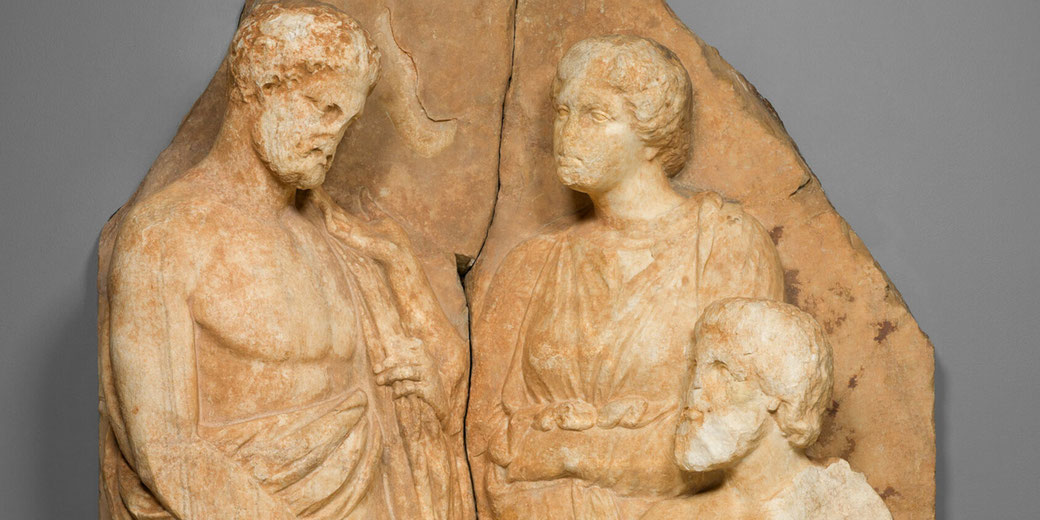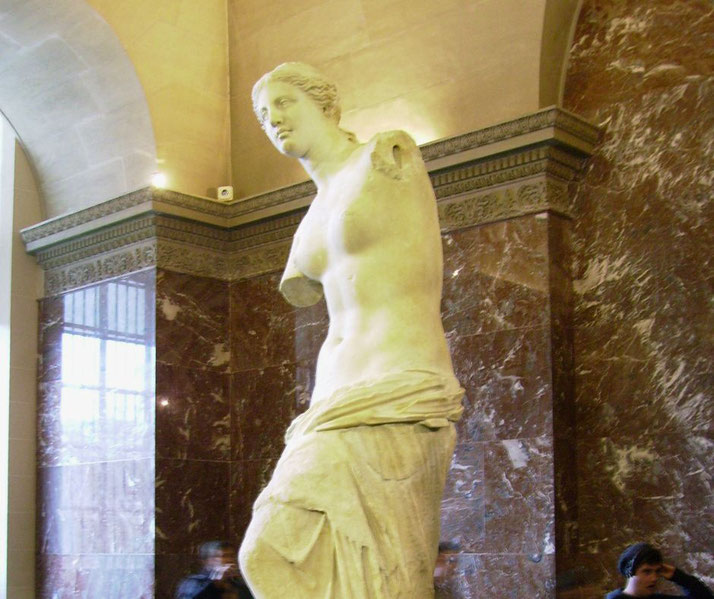What were ancient Greek families like?

During the Archaic Period of Ancient Greece, spanning from around 800 to 500 BC, the Greek world witnessed the rise of the polis, or city-state, a political and social structure that would come to define much of Greek life.
Within these emerging city-states, the family began to take on a form that would be recognizable throughout the Classical Period.
The oikos, as the basic family unit, became the cornerstone of both economic and social life, with land ownership and familial duties playing pivotal roles in defining one's place in society.
But what made the Greek family unit so important?
How did familial hierarchies shape the lives of individual people?
And how did family dynamics differ from one polis to another?
The oikos: The family and the household
The term 'oikos' primarily referred to the household, encompassing not just the physical dwelling but also the family members, slaves, and even the land and property associated with it.
This holistic concept of the household was central to the Greek understanding of personal identity and societal role.
An individual's standing, rights, and duties were often intrinsically tied to their position within the oikos, making it a microcosm of the broader societal hierarchy.
At the helm of the oikos was the kyrios, typically the eldest male, who held authority over all members of the household.
His responsibilities were manifold, ranging from managing the family's economic affairs to representing the household in civic matters.
The kyrios's authority was both a privilege and a duty, as he was expected to ensure the well-being and honor of all under his charge.
This patriarchal structure, while rigid, was seen as essential for maintaining order and stability within the household and, by extension, the community.
Yet, the oikos was far from being a domain solely dominated by men. Women, while often operating in more private spheres, played crucial roles in ensuring the household's smooth functioning.
Their responsibilities encompassed domestic chores, raising children, and often managing the household's finances in the kyrios's absence.
The bond between husband and wife, though often born out of societal obligations and economic considerations, could also be one of mutual respect and affection.
Children, too, held a special place within the oikos. Their upbringing and education were of paramount importance, as they were seen as the bearers of the family's legacy and honor.
Beyond the immediate family, the oikos also included slaves and sometimes hired workers.
While their roles were primarily servile, their contributions were indispensable for the household's daily operations.
The relationship between the family and slaves varied, with some slaves being treated with relative kindness and others facing harsher conditions.
Nevertheless, their presence underscores the multifaceted nature of the oikos, where economic, social, and personal dimensions intertwined.
How people got married in ancient Greece
Marriage and betrothal were important events in families' lives, holding both personal and societal significance.
These unions, often orchestrated with an eye towards familial and economic considerations, were not merely personal contracts but societal covenants, binding two families and, by extension, their broader communities.
The process of betrothal, or 'engyesis', was the first step in this journey towards marital union.
It was typically a formal agreement between the kyrios of the bride-to-be and the prospective groom.
While the bride's consent was not always a primary consideration, her well-being and compatibility with the groom were often taken into account by her family.
The engyesis was more than just a promise of marriage; it was a binding contract, often accompanied by exchanges of gifts and, more importantly, the dowry or 'proix'.
This dowry, provided by the bride's family, was both a testament to her status and a safety net, ensuring her financial security in her new home.
The marriage ceremony itself was a multi-day affair, steeped in rituals and traditions.
It began with the 'proaulia', a ceremony held at the bride's home, where she made offerings to the gods, especially Artemis, the protector of young girls.
This was followed by the wedding procession, where the bride was escorted to her new home, symbolizing her transition from her natal family to her marital one.
The culmination was the 'gamos', the wedding feast, a joyous celebration attended by friends and family, marking the couple's union.
While the structure of marriage in Ancient Greece was undeniably patriarchal, with the groom often being significantly older than the bride, the relationship within the marital bond could vary widely.
Some marriages, especially those of economic or political convenience, might remain transactional in nature.
However, many evolved into partnerships of mutual respect, affection, and collaboration.
The wife, while primarily overseeing the domestic realm, could wield significant influence within the household, guiding its moral and social compass.
Furthermore, the concept of love in marriage, though not always the primary impetus for union, was not absent.
Poets, playwrights, and philosophers often mused about the ideals of love, companionship, and partnership, suggesting that while marriages might have been arranged, genuine affection and understanding could blossom within them.

Important life milestones for children and adults
The journey of life in Ancient Greece was punctuated by a series of rites of passage, each marking a significant transition and bestowing upon the individual a new status within the societal tapestry.
These rituals, deeply embedded in the cultural and religious fabric of the time, provided both a spiritual framework and a communal affirmation of the individual's evolving role in society.
From the earliest days of life, a child was introduced to these rites. Shortly after birth, the 'amphidromia', or 'running around', ceremony took place.
In this ritual, the father would carry the newborn around the household hearth, symbolically integrating the child into the family and seeking the protection of the household gods.
This was followed, on the fifth or seventh day, by the naming ceremony, a significant event that officially recognized the child's identity and place within the community.
As boys approached adolescence, another crucial rite of passage awaited them: the 'koureion'.
This ceremony marked their transition from childhood to the cusp of manhood. Often, it involved physical challenges, educational tests, and religious rituals, all aimed at preparing the young man for his impending responsibilities as a citizen and a warrior.
In city-states like Sparta, this transition was particularly rigorous, with boys undergoing intense military training to mold them into formidable soldiers.
For girls, the passage from childhood to womanhood was marked by the 'Arkteia', a festival dedicated to the goddess Artemis.
Young girls, dressed in bear costumes, would participate in dances and rituals, symbolizing their transformation from wildness to domesticity.
This festival not only prepared them for their future roles as wives and mothers but also sought the blessings of Artemis, the protector of young girls and childbirth.
Marriage, as previously discussed, was another significant rite of passage, especially for women.
It marked their transition from their natal family to their marital household, bestowing upon them new roles and responsibilities.
For men, military service and participation in civic duties further affirmed their status as full-fledged citizens.
In the twilight years, as one approached the end of life's journey, rituals ensured a peaceful passage to the afterlife.
Funerary rites, with their elaborate ceremonies, offerings, and commemorations, ensured that the deceased was honored and remembered, and that their spirit found solace in the realm beyond.
The extended family: Gens and clans
Beyond the immediate confines of the oikos, the families of Ancient Greece extended into larger, more broader connections formed by gens and clans.
These extended family units, while rooted in blood ties and shared ancestry, were also powerful socio-political entities, wielding significant influence in the community and often shaping the course of local and regional affairs.
The 'gens', or genos in singular, was a kinship group that traced its lineage back to a common ancestor.
This ancestral connection was not merely a matter of pride but also of religious and cultural significance.
Each genos had its own set of rituals, festivals, and even dedicated shrines or altars to honor their forebears.
These ancestral rites not only reinforced the bonds of kinship but also ensured the continued blessings and protection of the ancestral spirits upon the living members of the genos.
As these gens grew and branched out, they often formed larger conglomerates known as clans or phratries.
These clans were alliances of several gens, bound together by shared traditions, mutual interests, and often, strategic necessities.
In the complex socio-political landscape of Ancient Greece, where city-states frequently vied for power and resources, these clans played a pivotal role.
Their collective strength, both in terms of manpower and resources, made them influential players in the political arena.
In city-states like Athens, phratries had specific roles in civic ceremonies and were integral to the functioning of the polis.
However, the significance of these larger family units was not solely political. On a personal level, they provided a broader network of support, guidance, and security.
In times of crisis, such as wars or famines, the clan often rallied together, pooling resources and ensuring the well-being of all its members.
Marriages, too, were often arranged within these extended networks, further strengthening the bonds between families and ensuring the continuity of traditions and values.
Family differences among city-states
While the different city-states of Greece were unified by shared language, religion, and cultural motifs, they were also distinct communities, each with its own unique flavor, governance, and societal norms.
These poleis, as they were known, were independent entities, often vying for dominance, influence, and resources.
And within the context of family and societal structures, the differences among these city-states were particularly pronounced, reflecting their diverse histories, priorities, and environments.
Athens, often heralded as the cradle of democracy, was a hub of intellectual, artistic, and political activity.
Much of the information and examples we have covered so far applies best to the Athenian context.
In particular for women, though primarily confined to the domestic sphere, played a crucial role in religious ceremonies and festivals, reflecting the city's deep reverence for its deities.
The emphasis on education, debate, and civic participation in Athens also influenced family dynamics, with the household often serving as a microcosm of the democratic processes of the city-state.
In stark contrast stood Sparta, with its militaristic ethos and rigid societal hierarchy.
The Spartan family was molded by the state to serve its primary objective: producing formidable warriors.
From a tender age, boys were taken from their families and placed in the 'agoge', a rigorous training regimen that prepared them for the hardships of war and communal living.
Women, while not warriors, were trained to be physically fit, ensuring they bore strong children.
Marriage and family life in Sparta were heavily influenced by the state's needs, with rituals and practices that emphasized duty, discipline, and the collective over individual desires.
Other city-states, like Corinth, known for its commerce and strategic location, or Thebes with its rich history and legendary military unit, the Sacred Band, also had their unique takes on family and societal structures.
Factors like economic priorities, military needs, and historical events shaped the family dynamics in each of these poleis, creating a rich mosaic of practices and norms.
What do you need help with?
Download ready-to-use digital learning resources
Copyright © History Skills 2014-2025.
Contact via email
With the exception of links to external sites, some historical sources and extracts from specific publications, all content on this website is copyrighted by History Skills. This content may not be copied, republished or redistributed without written permission from the website creator. Please use the Contact page to obtain relevant permission.





